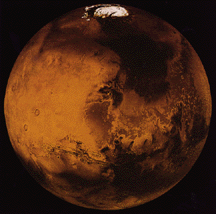What is happening with Mars this month?
![]()

On August 27, 2003, Mars and Earth will be separated by a mere 55.76 million km (34.65 million miles). Much has been made of the fact that the August 27th encounter with Mars is the closest in some 60,000 years. While this statement is certainly true, it is also a bit misleading. Mars and Earth have been almost this close many times in recent history. For example, the two planets were just over 56 million km apart on Aug. 23, 1924; Aug. 18, 1845; and Aug. 13, 1766. Nevertheless, the United States, Europe, and Japan are all sending space probes to Mars this year, taking advantage of the planet's closeness to shorten the travel time.
Astronomers call these close encounters "perihelic oppositions." Perihelic means Mars is near perihelion--its closest distance to our Sun. Remember that the orbit of Mars, like that of all planets, is an ellipse, so the distance between the Sun and Mars changes as it goes around its orbit. Opposition means that the Sun, Earth and Mars are in a straight line with Earth in the middle. Mars and the Sun are on opposite sides of the sky. When Mars is at opposition and at perihelion--at the same time--it is very close to Earth. While an opposition occurs about every two years, the combination of perihelion and opposition only occurs about every 50,000 years.
So go out this month and enjoy the sight of the fourth planet from the Sun as it graces the night sky. Observers in the Northern Hemisphere can see Mars shining brightly in the southern sky (in the constellation Aquarius) just before dawn. Starting in mid-July, Mars can be seen to rise in the east around 11 p.m. local time. By late August, Mars will appear in the eastern sky as soon as the Sun sets.
![]()
The StarChild site is a service of the High Energy Astrophysics Science Archive Research Center (HEASARC), within the Astrophysics Science Division (ASD) at NASA/ GSFC.
StarChild Authors: The StarChild Team
StarChild Graphics & Music: Acknowledgments
StarChild Project Leader: Dr. Laura A.
Whitlock
Curator:
Responsible NASA Official: